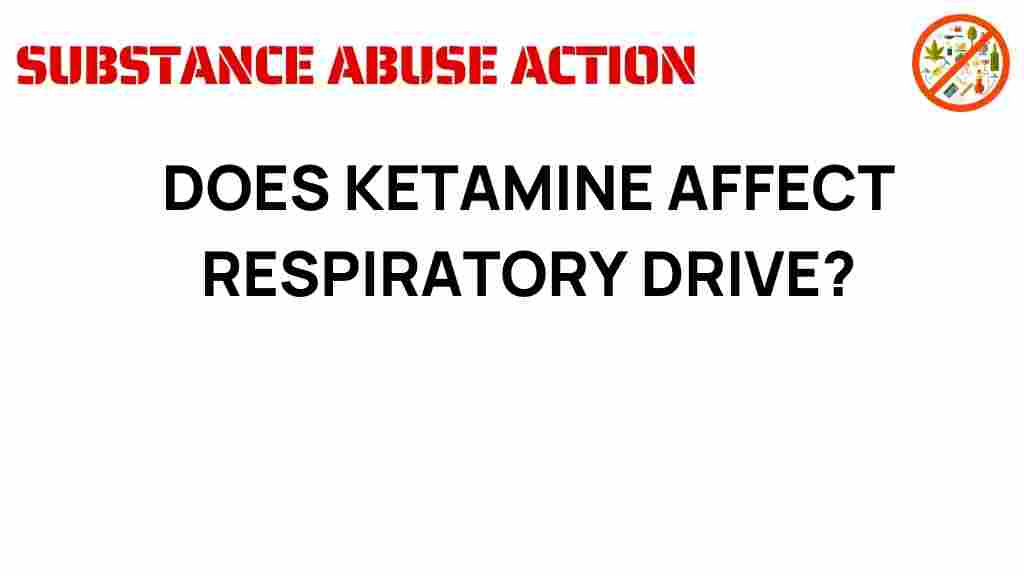Unraveling the Mystery: How Does Ketamine Influence Respiratory Drive?
Ketamine, a compound initially developed as an anesthetic, has garnered significant attention in recent years for its unique pharmacological properties and potential therapeutic applications in mental health. However, one of the lesser-discussed aspects of ketamine is its influence on respiratory drive. Understanding how ketamine affects respiratory drive is crucial for both its use in anesthesia and its emerging role in treating various mental health conditions. This article explores the relationship between ketamine and respiratory drive, detailing its effects, side effects, and the underlying pharmacology.
The Role of Respiratory Drive
Respiratory drive refers to the body’s mechanism for regulating breathing. It is influenced by various factors, including metabolic needs, carbon dioxide levels, and the central nervous system’s function. Changes in respiratory drive can significantly impact oxygenation and overall health.
Ketamine: An Overview
Ketamine is a non-competitive N-methyl-D-aspartate (NMDA) receptor antagonist that produces rapid anesthesia and analgesia. Initially used in surgical settings, its unique properties have led to investigations into its potential as a treatment for mental health disorders such as depression and PTSD. Its rapid onset of action distinguishes it from traditional antidepressants, which often take weeks to show effects.
How Ketamine Influences Respiratory Drive
The interaction between ketamine and respiratory drive is complex and multifaceted. Ketamine’s pharmacological effects can lead to both respiratory depression and stimulation, depending on the dosage and clinical context. Here’s a closer look at these influences:
1. Mechanism of Action
Ketamine primarily works by inhibiting NMDA receptors, but it also influences other neurotransmitter systems, including:
- Opioid receptors: Ketamine has affinity for mu and kappa opioid receptors, which can modulate pain and respiratory drive.
- Monoamine systems: By affecting serotonin and dopamine pathways, ketamine can influence mood and potentially respiratory patterns.
2. Respiratory Depression
At higher doses, ketamine can cause respiratory depression, which is a reduction in the urge to breathe. This effect is notable during surgical anesthesia. Factors contributing to respiratory depression include:
- Dosage: Higher doses are more likely to suppress respiratory drive.
- Administration route: Intravenous (IV) administration tends to have more immediate effects compared to intranasal or oral routes.
- Patient factors: Pre-existing respiratory conditions can exacerbate the effects of ketamine.
3. Respiratory Stimulation
Conversely, low to moderate doses of ketamine can stimulate respiratory drive. This is particularly relevant in the context of its use in mental health treatments. Some studies suggest:
- Ketamine can increase breathing rates in patients with depression.
- It may enhance overall respiratory function by improving mood and reducing anxiety, which in turn can affect breathing patterns.
4. Anesthesia and Ketamine
In anesthesia, ketamine is often used in combination with other agents to mitigate its respiratory effects. Anesthesiologists are trained to monitor and manage respiratory drive closely. The balance between sedation and respiratory function is critical, and ketamine’s unique properties allow for flexibility in these settings.
Research Insights
Numerous studies have investigated the effects of ketamine on respiratory drive, exploring both its anesthetic and therapeutic roles:
- Clinical Trials: Research has shown that ketamine can effectively treat treatment-resistant depression, often with minimal respiratory side effects when administered correctly.
- Animal Studies: Research in animal models has indicated that ketamine can modulate respiratory patterns, providing insights into its mechanisms.
- Case Studies: Individual cases highlight the variability in respiratory responses to ketamine, emphasizing the need for personalized approaches to treatment.
Side Effects of Ketamine on Respiratory Drive
Despite its benefits, ketamine is not without side effects. Understanding these is essential for safe administration:
- Respiratory Depression: As previously mentioned, high doses can lead to significant respiratory depression, necessitating monitoring.
- Upper Respiratory Tract Symptoms: Some patients report symptoms such as a runny nose or throat irritation post-administration.
- Psychological Effects: Ketamine can cause dissociative symptoms, which may indirectly affect breathing patterns.
Troubleshooting Tips for Ketamine Administration
When administering ketamine, especially in a clinical setting, consider the following tips to minimize risks related to respiratory drive:
- Monitor Vital Signs: Continuous monitoring of oxygen saturation and respiratory rate is crucial during administration.
- Start Low: Begin with lower doses to assess individual patient responses before titrating up.
- Be Prepared: Have resuscitation equipment readily available in case of severe respiratory depression.
- Consider Patient History: Take into account any pre-existing respiratory conditions and adjust dosages accordingly.
Conclusion
Ketamine is a powerful tool in both anesthesia and mental health treatment, but its effects on respiratory drive must be carefully managed. Understanding how ketamine influences respiratory drive enables healthcare professionals to optimize its use while minimizing risks. Ongoing research continues to shed light on this fascinating compound, promising new insights into its pharmacology and potential applications.
For further reading on the implications of ketamine in mental health treatment, you can explore this link.
To keep abreast of the latest research and developments surrounding ketamine and its effects, visit this external resource.
This article is in the category Treatment and created by SubstanceAbuseAction Team
